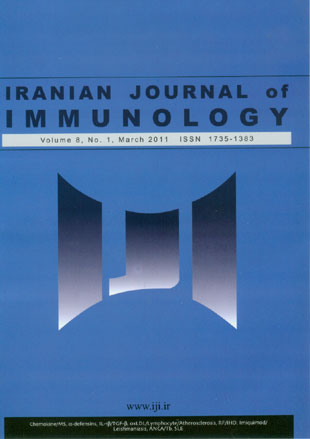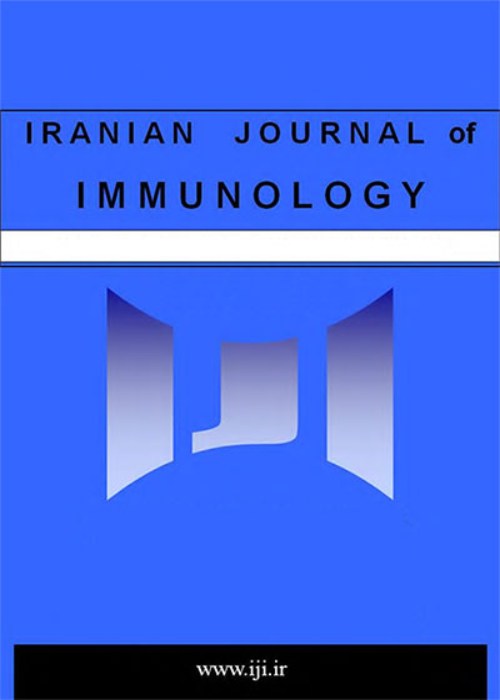فهرست مطالب

Iranian journal of immunology
Volume:8 Issue: 1, Winter 2011
- تاریخ انتشار: 1390/01/21
- تعداد عناوین: 8
-
-
Pages 1-10BackgroundTh1 cells preferentially express CXCR3, CCR5 and CCR6, while CCR3 and CCR4 are predominantly expressed by Th2 cell subsets. Multiple Sclerosis (MS) is a Th1cell-dependant chronic inflammatory disease of the central nervous system, andimmunomudolatory cytokines could alter the chemokine expression pattern of theselymphocyte subsets.ObjectiveThis study was performed to measure chemokine receptorexpression on CD4 T cells for evaluation of Th1/Th2 dominantly in IFN-β treated patients.Methodsflowcytometry was used to detect chemokine receptor expression on CD4 T cell population in PBMCs obtained from MS and healthy control groups. Twenty six MS patients participated in this study before and after IFN-β therapy and the same number of healthy individuals were included.ResultsThe percentage of lymphocytes was 41.28% ± 10.30 in the blood of MS group compared with 36.88% ± 5.51% in the control group (p=0.017). The CD4+CXCR3+ cells were 18.86% ± 8.46% in healthy group, 30.78% ± 9.8% in pre-treated MS patients and 21.06% ± 9.23% in post-treated group (p<0.001). The CD4+CCR4+ cellsubsets were 27.35% ± 10.15% in healthy group; 28.17% ± 8.9% in pre-treated group and 34.20% ± 8.96% in the post-IFN-β treatment group. The subset of CD4+CCR4+ was found to be dominant after IFN-β therapy in comparison with the control group (p<0.001). CD4+CCR5+ percentage was 1.24% ± 0.92% in the healthy people, 1.23% ± 0.71% in the MS patients and 0.76% ± 0.49% in post-treatment status (p=0.003). CD4+CCR3+ cell subsets were 0.62% ± 0.67% in control group, 0.28% ± 0.26% in the MS patients (p=0.022) and 0.39% ± 0.54% in IFN-β treated patients (p=0.334). An association was found for CXCR3 expression in pre- and post- treatment status (r=0.840, p<0.001) as well as for CCR4+ expression (r=0.712, p<0.001) in the same groups. The Th1 response was dominant in pretreatment states, and then it shifted to a Th2 dominant state after IFN-β treatment.ConclusionWe suggest that the chemokine receptor expression of Th1/Th2 cell subsetscould be used for monitoring and the evaluation of the MS disease status.
-
Pages 11-19BackgroundThe infectious nature of severe early-childhood caries (S-ECC) points to the possible participation of immunologic host responses including neutrophils and their antimicrobial products.ObjectivesThe aim of this study was to determine the neutrophil apoptosis, α-defensins (HNP1-3) and calprotectin levels in the saliva of preschool children and the association with S-ECC.MethodsOral examinations were performed on 87 children aged 3-5 years and non stimulated whole saliva samples were collected. Thirty of these subjects were considered S-ECC children, 30 with moderate caries (MC) and 27 were caries free (CF). To detect apoptosis, cell staining was done with Annexin-V-Fluos and propidiumiodide, and they were analyzed by fluorescent microscopy. The concentration of α-defensins and calprotectin were assessed using ELISA.ResultsThere were no statistical differences between groups considering the HNP1-3 or calprotectin salivary levels (p=0.06 and p=0.23, respectively). The HNP1-3 and calprotectin levels were negatively correlated and the correlation was significant in MC group (p=0.03). Lower levels of apoptotic neutrophils were obtained from CF subjects as compared with S-ECC children (p=0.03).ConclusionsOur findings establish that apoptotic mechanisms could be implicated in the immunity responses associated with S-ECC. We cannot yet determine if the level of salivary α-defensins or calprotectin is predictive of S-ECC.
-
Pages 20-26BackgroundGrowth factors play a major part in wound healing in many tissues including the periodontium. Transforming growth factor-β1 (TGF-β1) is one of these factors present in the gingival crevicular fluid. In addition, it is considered as one of the most important antiinflammatory cytokines. Interleukin-1β is a proinflammatory cytokine that presents itself in gingival inflammation and the GCF. Such factors might be of value as prognostic markers of wound healing activity and the therapeutic progress following flap surgery.ObjectiveThe aim of this study was to evaluate the effect of surgical flap on the concentration of IL-1β and TGF-β in the GCF of patients with moderate to severe chronic periodontitis.MethodsThe GCF samples were collected, using the Perio-Paper strip at phase 1 (pre-surgery), phase 2 (4th week post surgery) and phase 3 (12th week post surgery) from 20 sites of 10 patients undergoing flap surgery. After the elution, IL-1β and TGF-β concentrations were measured by enzyme-linked immunosorbent assay (ELISA).ResultsThe mean TGF-β and IL-1β concentration decreased from phase 1 to phase 3 (p<0.05). There were no significant statistical correlations between IL-1β and TGF-β1 concentrations in the 3 assessment phases.There was a significant statistical correlation between TGF-β1 concentrations and the Plaque Index (PI) in phase 2 (p<0.05). There was a significant statistical correlation (p<0.05) between IL-1β and TGF-β1 concentration and the probing pocket depth (PPD).ConclusionThe flap surgery has a significant effect on decreasing IL-1β concentration. In the case of TGF-β1, probably the decrease in the concentration after treatment might be due to the removal of the inflammatory stimulants.
-
Pages 27-33BackgroundAtherosclerosis, a chronic inflammatory disease of the vessel wall ischaracterized by local and systemic immune responses to a variety of antigens. Oxidized lowdensity lipoprotein (oxLDL) is considered as an important determining factor in thepathogenesis of atherosclerosis.ObjectiveThe purpose of this study was to investigate the degree of peripheral blood mononuclear cells (PBMC) vulnerability to in vitro oxLDL-inducedcytotoxicity from atherosclerotic patients in comparison to healthy individuals.MethodsThirty patients with atherosclerotic lesions, confirmed by angiography, and 30 matched healthy individuals were investigated. PBMC was prepared from individual's blood samples which were further stimulated with low dose (1 μg/mL) and high dose (50 μg/mL) of extensively oxidized LDL. MTT assay was utilized to measure cell viability and proliferation. Stimulation index (SI) was calculated as mean ratio of optical density (OD) of the stimulated cells divided by OD of untreated cells.ResultsLow dose oxLDL treatment caused no significant proliferative or cytotoxic effect in the control group; however, similar treatment caused significant cytotoxic effect in the patient group compared to the controls (p=0.026). High doseoxLDL treatment induced more significant cytotoxicity in the patient compared to the control group (p=0.006). Comparison of the SI between the two groups of patients and controls showed significantly lower index by either the low (p=0.03) or the high dose (p<0.001) oxLDL in the patients compared to the controls.ConclusionsPBMC from patients with atherosclerosis showed increased susceptibility to oxLDL-induced cytotoxicity. Our results imply that prolonged exposure to elevated levels of circulating oxLDL could weaken the cellular defense mechanisms by progressive depletion of the pool of antiapoptotic proteins, rendering the cellsmore vulnerable to oxLDL-induced cell death.
-
Pages 34-44BackgroundImmunopathological and inflammatory processes play important roles in the initiation and development of Ischemic Heart Disease (IHD).ObjectiveThe aim of this study was to evaluate the serum levels of several autoantibodies including rheumatoid factor (RF), anti-nuclear antibodies (ANA), anti-small nuclear ribonucleoprotein (anti-Sm), antiphosphatidylserine (anti-PS) and anti-cardiolipin (anti-CL) antibodies in patients with IHD.MethodsA total of 120 patients with IHD with acute myocardial infarction (AMI; n=60) or unstable angina (UA; n=60) and 60 sex- and age-matched healthy subjects were enrolled in this study. Serum samples of participants were tested for the ANA, anti-Sm, anti-PS and anti- CL antibodies by ELISA. Serum level of RF was measured by a turbidometric method.ResultsThe mean serum levels of RF and anti-PS antibodies in AMI group and UA group were significantly higher than those observed in the control group (p<0.0001). The mean serum levels of RF and anti-PS antibodies in AMI patients were significantly higher than the UA group (p<0.01 and p<0.001, respectively). The mean serum levels of RF in men with AMI or UA diseases were significantly higher as compared to healthy control men (p<0.0001 and p<0.003, respectively). The differences of the serum levels of ANA, anti-Sm and anti-CL antibodies were not significant between AMI, UA and the control groups. There was no difference in the serum levels of RF, ANA, anti-Sm, anti-PS or anti-CL antibodies in patients with traditional risk factors, including hypertension, dyslipidemia, diabetes and smoking, and those without a certain risk factor.ConclusionHigher serum levels of RF and anti-PS antibody in patients with IHD may be considered as independent risk factors for IHD.
-
Pages 45-51BackgroundLeishmaniasis is a complex disease which presents as visceral, cutaneous and mucocutaneous forms. The current treatment options for this infection are very limited and the immunological state of the host appears to play an important role in the efficacy of the treatment. Immunostimulation through immune response activating agents such as Imiquimod is another rational approach for this purpose.ObjectiveWe assessed the efficacy of immunotherapy with Imiquimod alone or combined with Glucantime for treatment of Leishmania major infection in BALB/c mice.MethodsTreatment efficacy was monitored by determination of thickness and parasite load of infected footpad of mice.ResultsThe footpad thickness revealed that treatment with Imiquimod plus Glucantime has the highest efficacy. The results were confirmed by parasite load of infected footpad. Our data shows that treatment of Leishmania major infection in BALB/c mice by the combined Imiquimod and Glucantime is more efficient than each drug alone.ConclusionThe combination of Imiquimod with chemotherapy may offer a way for more efficient treatment of leishmaniasis.
-
Pages 52-57BackgroundMycobacterium tuberculosis is a major cause of mortality and morbidity worldwide. Infection with this bacterium is known to induce the development ofautoantibodies of which a few are also known to be diagnostic markers for some otherdiseases. Antineutrophil Cytoplasmic Antibodies (ANCAs) are among those autoantibodiesused in clinical setting for diagnosing systemic vasculitic syndromes. Multiple studiesinvestigated ANCA positivity in diseases other than small vessel vasculitis.ObjectiveThis study was performed to determine the prevalence of ANCA in pulmonary tuberculosis (TB) which may lead to the false diagnosis of Wegener's granulomatosis (WG) or vice versa.MethodsIn a case-control study, 32 consecutive smear positive pulmonary TB patients and 32 normal individuals were studied. All cases and controls were screened for ANCA by indirect immunofluorescent assay (IIF), and MPO and PR3 were also tested by ELISA.ResultsA prenuclear pattern (P-ANCA) was detected in 25% of the cases and 6.25% of the controls and a cytoplasmic pattern (C-ANCA) was deserved in 3.1% of both the cases and the controls by IIF assay. ANCA specificities tested by ELISA in cases revealed that 75% of the cases had anti-MPO and 12.5% had anti-PR3, while in the in controls, 3.12% had anti-MPO and none had anti-PR3. The positive ANCA significantly correlated with TB (p<0.01).ConclusionANCA's may be observed in both TB and systemic vasculitic syndromes such as WG. Tuberculosis and WG share some clinical features. Therefore, in countries with a high prevalence of TB, one has to distinguish between these two diseases especially when no sign of extrapulmonary involvement is observed.
-
Anti-S Alloantibody Underlying Pan Agglutinating Autoantibody in a Patient of Systemic Lupus ErythematosusPages 58-63


